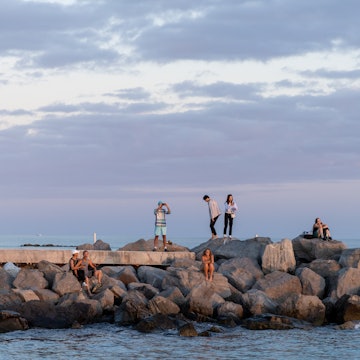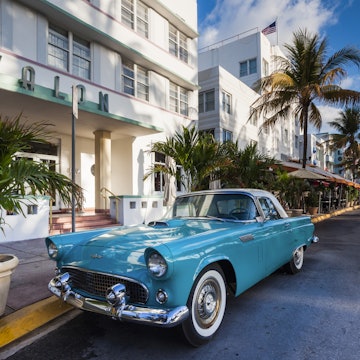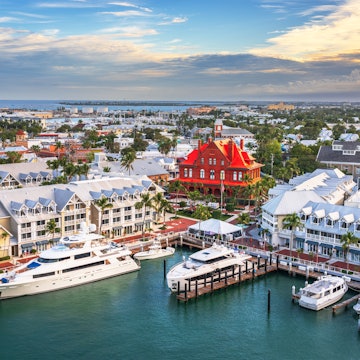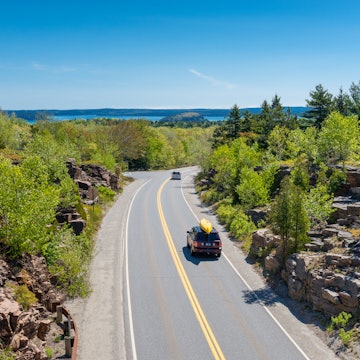

Highway A1A near Jacksonville, Florida. Frame Craft 8/Shutterstock
In a funny reversal of geography, northeast Florida reveals the Sunshine State’s Southern charm far more than its southern reaches.
The 250-mile strip of Atlantic coastline unfurling from the Georgia border down to Interstate 4 offers up an interconnected web of lively metro areas, shoreline towns, rural enclaves, state parks and miles of beaches. The pace is slower up here than in Miami, Orlando or Tampa, in what locals call “Old Florida” – in some cases, they mean really old Florida: St Augustine was founded almost 500 years ago!
This 225-mile, eight-day itinerary will show you the best of northeast Florida, taking in historic monuments, lively cities and scenes of remarkable natural beauty. Oh, and a beach or two (or a dozen) – sand is Florida’s common denominator, after all!
How to get around
Since public transit options are limited in Florida, you’ll need a car to tackle this itinerary. We highly recommend skipping the I-95 freeway and taking it slow along State Road A1A. Hugging the coast from Jacksonville to Daytona Beach (then running all the way south to Key West), this highway will remind you why so many people want to live in this part of the world.
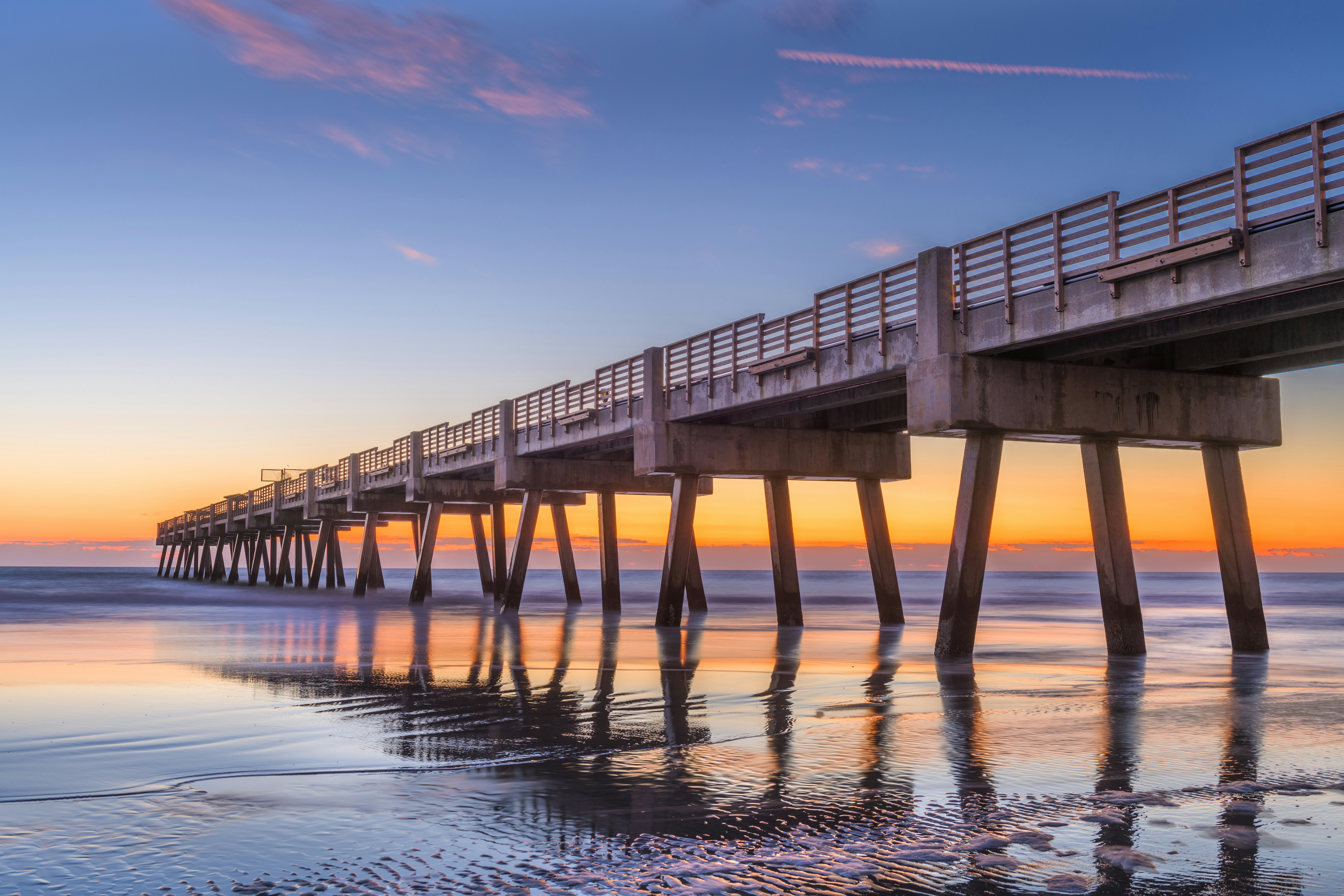
Days 1–2: Experience Southern hospitality (and divine beaches) in Jacksonville
Florida’s most populous municipality, sprawling, football-mad Jacksonville can feel like a small country town dressed in big-city clothes. Residents here are noticeably friendlier than in other major Florida cities, spending much of their time outdoors fishing, surfing and watching live sports. Experience the city’s hospitality by sinking a few beers in the Five Points neighborhood, or get a dose of culture at the lovely Cummer Museum of Art.
Then, do as folks in Jax do and head east to the beaches. Jax Beach on Florida’s First Coast is best for nightlife, while Neptune Beach is small and surfing-oriented, and Atlantic Beach is great for nature, shopping and art. All are laid-back, with flip-flops (or bare feet) encouraged.
Radically different from the hard-packed, golden-sand beaches further south, Black Rock Beach was formed at the end of the last Ice Age, some 10,000 years ago. Live oak and cedar tree skeletons carved by wind and water line a shoreline composed of geological soil formations that appear almost primordial. It’s not so much a beach to sunbathe on as a place to connect with the region’s prehistoric past.
For another take on nature, sample Jacksonville’s remarkable green spaces. With 405 local parks, seven state parks, two national parks and fabulous botanical gardens, the city boasts the USA’s largest urban park system. At Jacksonville Arboretum & Gardens, seven short, dog-friendly nature trails up to a mile long spiderweb through 136 acres of lush foliage, with a hundred tagged native plants.
Nature lovers will feel right at home biking or hiking the mile-long wooded path and boardwalk at Castaway Island Preserve, its river marshes frequently abuzz with canoeists and kayakers. If you’d rather take your car, Huguenot Memorial Park has the only beach in Jacksonville where you can drive on the sand.
Planning tip: While the fall football showdown between the University of Florida Gators and arch-rivals, the University of Georgia Bulldogs, is Jacksonville’s most popular annual event, consider timing your trip to coincide with one of the city’s big music festivals. Springing the Blues draws upward of 125,000 visitors to the Seawalk Pavilion each spring, while the Jacksonville Jazz Festival draws big names to downtown each May.
Every November, Jacksonville PorchFest offers free concerts on the porches of historic homes in the Springfield neighborhood, plus more music in Sesquicentennial Park.

Day 3: Delve into history in charming St Augustine
40 miles south of Jacksonville
Founded in 1565, St Augustine is the oldest city of European origin in the United States. Amid Florida’s endless housing developments and commercial strips, the narrow, cobblestone streets, wooden balconies and patinaed walls you’ll find in its super-walkable center provide an eye-opening reminder of the state’s European heritage.
Lined with charming shops peddling handmade sweets (try the fudge from Kilwins), tacky souvenirs, blown-glass confections and artisanal jewelry, cobblestone St George St is the hub of the city's historic district. Restaurants serve fragrant baked goods, glasses of Spanish red, aromatic espresso and tapas plates; the atmosphere at The Floridian is especially evocative. Some taverns feature live entertainment at weekends, with the sound of violins, acoustic guitars and melodic voices mixing in the air.
There are numerous monuments to admire. Built in 1797, the historic Cathedral Basilica of St Augustine was remodeled under the guidance of renowned architect James Renwick Jr after a ravaging fire spared its coquina rock foundations in 1887.
A short walk from the basilica's southern end is Plaza de la Constitución, with giant oak-shaded eateries and galleries, and the diminutive, open-air Slave Market pavilion, a reminder of one unfortunate aspect of the region's past. Indeed, history is everywhere in St Augustine, and every block is packed with so many stories that it would take a full weekend to stop and read all the historic-marker plaques.
Planning tip: Hands down, the easiest – and most fun – way to get around St Augustine is aboard a kiddie-train-style trolley. The hop-on-hop-off Old Town Trolley has 22 stops and offers regular 90-minute tours. Along the route, a guide will regale you with interesting anecdotes and amusing tales about the businesses and historic sites you’re passing.
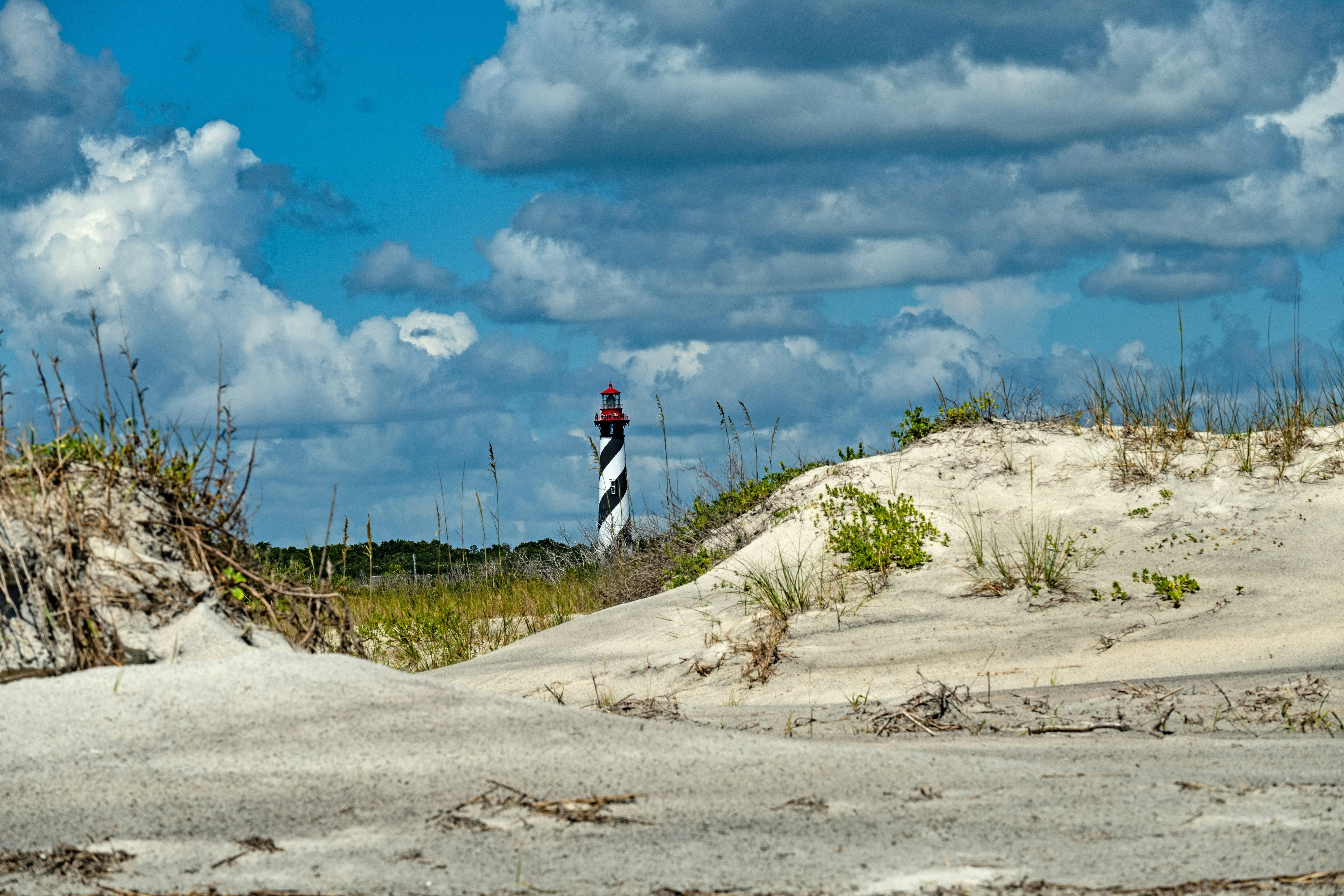
Day 4: Get close to dolphins on Anastasia Island
4 miles southeast of St Augustine
After all that history, it’s back to the beach. Across from St Augustine via the grand Bridge of Lions lies lovely Anastasia Island, home to Anastasia State Park and its 1600 acres of buttery dunes and miles of dreamy Atlantic coastline.
Recreation options abound. You can take to the water in a kayak or sailboat, hit a playground with the kids, or scope out the picture-perfect St Augustine Lighthouse. Or you can have a swim, sharing the waves with dolphins, stingrays, nesting sea turtles, and an array of native and migratory birds. Even with all this, there’s something to be said for getting to Anastasia and doing absolutely nothing.
The park is a beautiful place to camp. Seasoned campers know to book their spots up to 11 months early for busier times such as weekends and holidays. Starting at $28, tent or RV camping is far less expensive than a hotel room and it offers a much more scenic experience.
Detour: If you’re more interested in how other species appreciate this special place, get up close and personal with bottlenose dolphins, whose fins you’ll frequently see slicing the surface of the water. You can see and "hear" these fascinating ocean dwellers with the marine naturalists at St Augustine ECO Tours, aboard a vessel equipped with underwater microphones for conducting dolphin population studies.

Day 5: Bring your kayak, fishing pole and love for nature to the Matanzas River
14 miles south of Anastasia State Park
Continuing south along the coast, you’ll find another preserve of undeveloped beauty in this heavily built-up area. Adjacent to Marineland – a former oceanarium built in the 1930s as an underwater filming location, but today home to dolphins raised ethically for marine research – is the River to Sea Preserve. This 90-acre haven provides access to the Matanzas River, one of north Florida’s purest and most serene waterways.
Spend peaceful hours here kayaking, canoeing or stand-up paddleboarding on the river’s calm waters, pushing through maritime hammock woodlands and keeping an eye out for birds and darting fish. If you don’t have your own boat, book an educational tour aboard a vessel fueled by used vegetable oil with Ripple Effect Ecotours. Playful Atlantic bottlenose dolphins enjoy pacing the boats, and it’s not uncommon to see the heads of curious sea turtles poking up above the waves. Depending on the time of year, you might even spot a West Indian manatee.
A bit further north toward St Augustine on the A1A, Matanzas Inlet bristles with local fishers hooking flounder, whiting and bluefish; you might encounter the occasional sea turtle, too. During tidal flows, Matanzas Inlet flows high underneath the bridge, creating ideal fishing conditions.
Because the west side of the bridge is sheltered from waves and set back from the road, it exudes an air of seclusion and calmness. Here, you can spread a blanket on the golden sand, watch dolphins and luxury boats zip by, or hop aboard a free ferry to explore nearby Fort Matanzas, a citadel of Spanish colonial power.

Day 6: Frolic in the sun – and smell the car fumes – at Daytona Beach
37 miles south of the River to Sea Preserve
At in-your-face Daytona Beach, you can catch a race at the Daytona Speedway, take the kids to the arcades at the Daytona Lagoon or frolic with spring breakers by the ocean. The resort’s eclectic blend of residents and visiting tourists, motorsports fans and bikers makes for an energy-packed mix.
As its name implies, beaches are a big deal here, with 23 miles of blue waves splashing onto hard-packed white sand. The beach around Daytona Beach Boardwalk and Pier remains a favorite, although it’s often packed. Sun Splash Park, just five minutes from downtown, is another excellent option – especially for kids, who go nuts cavorting around its outdoor water pads.
Driving (and parking) on the sand is permitted at designated locations, and subject to certain rules. Download the Volusia Beach app for up-to-date access locations and rates. Bonfires – another local tradition – are allowed without a permit at designated locations on the sand.
Then there’s Daytona’s other big claim to fame – motorsports. Ever since motorcycle and car racing began kicking up sand here in 1902, speed freaks have converged to indulge their lust for everything fast. The Daytona 500 is the most prestigious event held by the racing organization NASCAR, which was founded here in 1948. This annual, 200-lap race has taken place at the Daytona Speedway since its inception in 1959, inspiring many similar events around the country.
Planning tip: You won’t be the only racing fan interested in coming for the Daytona 500 in February. Tickets sell out a month ahead of the big race, and hotels well before that – so make your plans early. If you want action with a little less frenzy, consider attending the Duel at Daytona, held the week before the Daytona 500. Other good options include the night races in August and January’s Rolex 24.

Days 7–8: Savor culture and nature on Amelia Island
122 miles north of Daytona Beach
Conclude your exploration of northeast Florida’s loveliest spots by looping back north, past Jacksonville and almost to the state line, to marvelous Amelia Island. This special place straddles the line between country club and secluded island escape, with pristine parks, uncrowded beaches, and many tales to tell about its swashbuckling, bootlegging, military and seafaring past.
Amelia Island's three towns – Fernandina Beach, American Beach and American City – lean affluent but not pretentious, offering a great blend of culture and nature. Stay in a Victorian B&B and feast on gourmet seafood (we love Brett’s Waterway Cafe), then hit the outdoors with a paddle around the barrier islands.
You’ll find a pronounced arts scene here, too. Annual events include chamber-music festivals, the elite Concours d’Elegance historic-car show and the enormously popular Isle of Eight Flags Shrimp Festival, which attracts some 150,000 people each May.
Striking preserved areas include the Fort Clinch and Amelia Island State Parks. The area’s lovely year-round weather bodes well for outdoor enthusiasts who come here to golf, hike, boat, kayak, canoe, fish and swim. The island is also favored by equestrians, who ride along quiet shores where horseback riding is not just allowed but encouraged.
This article was adapted from the 11th edition of Lonely Planet’s Florida guidebook, published in August 2025.








